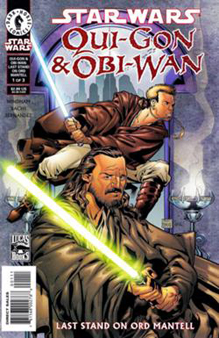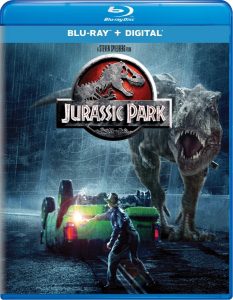One of the best parts of the prequel era opened up by 1999’s “Episode I: The Phantom Menace” was the opportunity to see the Jedi doing Jedi stuff at the height of their power and respect in the galaxy. While the film is a decent adventure for Jedi Master Qui-Gon Jinn and his apprentice, Obi-Wan Kenobi, the story is arguably hijacked by the Jedi Council, Anakin, Padme and the Gungans. “Qui-Gon & Obi-Wan” (2000-02), two short comic series, put the focus back on the Jedi team.
The first series chronologically, the two-issue “The Aurorient Express” (2002), strikes a comedic tone. Granted, there is a slight tinge of dry comedy in this master-Padawan relationship in the film – “You were right about one thing, master. The negotiations were short” – but scripter Mike Kennedy (“Underworld: The Yavin Vassilika”) takes this to another level with the way the duo’s stoicism contrasts with the shipboard absurdity. It’s all enhanced by the fact that “Tag and Bink” artist Lucas Marangon emphasizes facial expressions.
The plot riffs on the 1934 Agatha Christie novel “Murder on the Orient Express,” where it turns out that almost everyone on board a train had a hand in the murder. In the roles of Hercule Poirot and Arthur Hastings, Qui-Gon and Obi-Wan remain focused on their investigation as the rich passengers on a doomed ship scheme and bicker.

“Aurorient Express” is a quip-filled ride, and the Jedi are in character, but I was surprised to find I liked the more straightforward three-issue “Last Stand on Ord Mantell” (2000-01) better. It’s written by Ryder Windham, whose 1990s work on “Droids” I found boring, but he shows significant improvement here. Again, the duo is mired in a mysterious plot, but this one is more expansive, flowing from Coruscant to a derelict spaceship to Ord Mantell.
In addition to the title planet – first mentioned by Han in “Empire” – “Last Stand” incorporates several other elements that link the Prequel Trilogy to the Original Trilogy: Savrips (first seen as game pieces on the dejarik board on the Millennium Falcon), an Incom T-24 airspeeder (which looks like a green snowspeeder with an extra fin on top), a moisture farm, a swoop bike and a villain’s lair that looks kind of like Jabba’s.
Windham peppers in a bit of that dry humor. Obi-Wan suggests that Baroness Omnino chose Qui-Gon to investigate her son’s disappearance because she’s romantically interested in Qui-Gon. When his master sputters a flustered defense, Obi-Wan casually says “Forgive me, master. As you said, she may be delusional.” And Windham shows a good sense of the Jedis’ traits later on, when Obi-Wan wants to rush off and rescue the cute farmer’s daughter while Qui-Gon suggests they stop to analyze the mystery rather than making a brash decision.
We know that Qui-Gon wasn’t infallible (ultimately, Yoda was more right about Anakin than Qui-Gon was – although, yes, it could be argued that the Jedi Council helped push Anakin to the dark side). However, prior to the unfortunate events of the prequels, Qui-Gon’s emphasis on the Living Force (a philosophy that the present is paramount, and that instincts can be honed by being in tune with all living beings) served him well, and “Last Stand on Ord Mantell” is a prime example. (It served him well after death, too, as he became the first Jedi to learn how to live on as a Force ghost. And from the great beyond, he taught this trick to Yoda, Obi-Wan and Anakin as well, although those stories haven’t been specifically told. He may have taught Luke, too, as Luke’s ghost appears in the “Legacy” comics.)

Many fans felt Liam Neeson’s Qui-Gon was the best character in “The Phantom Menace,” but there are disappointingly few novels or comics about him – “Jedi: The Dark Side” told an earlier Qui-Gon yarn to tie in with the “Episode I” 3-D release in 2011, and he investigates taxation intrigue in the 2001 novel “Cloak of Deception.” At least he is warmly and accurately portrayed in these two “Qui-Gon & Obi-Wan” series.

